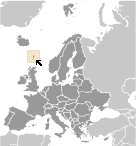World Atlas: Faroe Islands. On this page you can see the map, country flag and many detailed information about the people, history and economy of Faroe Islands.

Here you can find online selected information about the geography, inhabitants, government, economy and history of Faroe Islands. Included are selected statistics, an overview map and the detailed map of Faroe Islands. But let's start with the flag of Faroe Islands here:
Faroe Islands - Overview:
What you should know about Faroe Islands? Let's start with this: The population of the Faroe Islands is largely descended from Viking settlers who arrived in the 9th century. The islands have been connected politically to Denmark since the 14th century. A high degree of self-government was granted the Faroese in 1948, who have autonomy over most internal affairs while Denmark is responsible for justice, defense, and foreign affairs. The Faroe Islands are not part of the European Union.
Geography of Faroe Islands
 Where on the globe is Faroe Islands? The location of this country is Northern Europe, island group between the Norwegian Sea and the North Atlantic Ocean, about halfway between Iceland and Norway. Total area of Faroe Islands is 1,393 sq km, of which 1,393 sq km is land. So this is quite a small country. How could we describe the terrain of the country? This way: rugged, rocky, some low peaks; cliffs along most of coast. The lowest point of Faroe Islands is Atlantic Ocean 0 m, the highest point Slaettaratindur 882 m. And the climate is mild winters, cool summers; usually overcast; foggy, windy.
Where on the globe is Faroe Islands? The location of this country is Northern Europe, island group between the Norwegian Sea and the North Atlantic Ocean, about halfway between Iceland and Norway. Total area of Faroe Islands is 1,393 sq km, of which 1,393 sq km is land. So this is quite a small country. How could we describe the terrain of the country? This way: rugged, rocky, some low peaks; cliffs along most of coast. The lowest point of Faroe Islands is Atlantic Ocean 0 m, the highest point Slaettaratindur 882 m. And the climate is mild winters, cool summers; usually overcast; foggy, windy.
Inhabitants of Faroe Islands
Let's take a look how many people live in Faroe Islands. The number is: 50,730 (July 2017 est.). So not so many people live here. Who lives here? Faroese 88% (Scandinavian and Anglo-Saxon descent), Danish 7.6%, other 4.4% (includes Icelandic, Norwegian, Greenlandic, Filipino, Thai, British). What are the languages in Faroe Islands? Faroese 93.8% (derived from Old Norse), Danish 3.2%, other 3% (2011 est.). And the religions: Christian 89.3% (predominantly Evangelical Lutheran), other 0.7%, more than one religion 0.2%, none 3.8%, unspecified 6% (2011 est.). How old are the people in average? 37.6 years. We have to add that this number is the median - so one half of the people is older than this, one half is younger. And what is their life expectancy (at birth)? This: 80.5 years. Where the people live in Faroe Islands? Here: the island of Streymoy is by far the most populous with over 40% of the population; it has approximately twice as many inhabitants as Eysturoy, the second most populous island; seven of the inhabited islands have fewer than 100 people. The major urban areas of Faroe Islands are: Torshavn (capital) 21,000 (2014).
Government and Economy of Faroe Islands
The capital of Faroe Islands is Torshavn and the government type parliamentary democracy (Faroese Parliament); part of the Kingdom of Denmark. Let's take a look at the administrative divisions - none (part of the Kingdom of Denmark; self-governing overseas administrative division of Denmark); there are no first-order administrative divisions as defined by the US Government, but there are 30 municipalities. Regarding the economy of Faroe Islands, important industrial products are fishing, fish processing, tourism, small ship repair and refurbishment, handicrafts. Important agricultural products are milk, potatoes, vegetables, sheep, salmon, herring, mackerel and other fish. The most important export commodities are fish and fish products (97%) (2017 est.) and the most important export partners are UK 17.8%, Russia 17.3%, Germany 9.8%, China 9.2%, Denmark 6.5%, US 6%, Spain 4.8%, Poland 4.3% (2016). The most important import commodities are goods for household consumption, machinery and transport equipment, fuels, raw materials and semi-manufactures, cars and the most important import partners are Denmark 26.6%, Germany 10.7%, China 10.6%, Norway 10.2%, Poland 6.2%, Ireland 5%, Chile 4.2% (2016). How rich is Faroe Islands and how rich are people in this country? The most important number here is GDP per capita (PPP): $40,000 (2014 est.). This means the living standards are good here. Let's add that this means Gross Domestic Product per person, which is recalculated with respect to the relative cost of local goods and services. And one more important number - population below poverty line: 4.2% (2012 est.).